The Effect of Personalized Shoe Insoles on Parkinson’s Disease Subjects: A Triple-Blind Randomized Controlled Trial
Abstract
:1. Introduction
2. Materials and Methods
2.1. Selection of Patients
2.2. Randomization and Blinding
2.3. Outcome Assessment
2.4. Insoles
2.5. Intervention
2.6. Statistics
3. Results
3.1. Immediate Effect of Insoles Application
3.2. Long-Term Effect of the Insoles
3.3. Satisfaction with Insoles
4. Discussion
5. Conclusions
Supplementary Materials
Author Contributions
Funding
Institutional Review Board Statement
Informed Consent Statement
Data Availability Statement
Conflicts of Interest
References
- Pringsheim, T.; Jette, N.; Frolkis, A.; Steeves, T.D.L. The prevalence of Parkinson’s disease: A systematic review and meta-analysis. Mov. Disord. 2014, 29, 1583–1590. [Google Scholar] [CrossRef] [PubMed]
- Hayes, M.T. Parkinson’s Disease and Parkinsonism. Am. J. Med. 2019, 132, 802–807. [Google Scholar] [CrossRef] [PubMed]
- Abbruzzese, G.; Marchese, R.; Avanzino, L.; Pelosin, E. Rehabilitation for Parkinson’s disease: Current outlook and future challenges. Parkinsonism Relat. Disord. 2016, 22 (Suppl. 1), S60–S64. [Google Scholar] [CrossRef] [PubMed]
- Tomlinson, C.L.; Patel, S.; Meek, C.; Herd, C.P.; Clarke, C.E.; Stowe, R.; Shah, L.; Sackley, C.M.; Deane, K.H.; Wheatley, K.; et al. Physiotherapy versus placebo or no intervention in Parkinson’s disease. Cochrane Database Syst. Rev. 2013, 2013, CD002817. [Google Scholar] [CrossRef] [PubMed]
- Dockx, K.; Bekkers, E.M.; Van den Bergh, V.; Ginis, P.; Rochester, L.; Hausdorff, J.M.; Mirelman, A.; Nieuwboer, A. Virtual reality for rehabilitation in Parkinson’s disease. Cochrane Database Syst. Rev. 2016, 2016, CD010760. [Google Scholar] [CrossRef] [PubMed]
- Carmignano, S.M.; Fundarò, C.; Bonaiuti, D.; Calabro’, R.S.; Cassio, A.; Mazzoli, D.; Bizzarini, E.; Campanini, I.; Cerulli, S.; Chisari, C.; et al. Robot-assisted gait training in patients with Parkinson’s disease: Implications for clinical practice. A systematic review. NeuroRehabilitation 2022, 51, 649–663. [Google Scholar] [CrossRef] [PubMed]
- Lihala, S.; Mitra, S.; Neogy, S.; Datta, N.; Choudhury, S.; Chatterjee, K.; Mondal, B.; Halder, S.; Roy, A.; Sengupta, M.; et al. Dance movement therapy in rehabilitation of Parkinson’s disease–A feasibility study. J. Bodyw. Mov. Ther. 2021, 26, 12–17. [Google Scholar] [CrossRef] [PubMed]
- Yu, X.; Wu, X.; Hou, G.; Han, P.; Jiang, L.; Guo, Q. The Impact of Tai Chi on Motor Function, Balance, and Quality of Life in Parkinson’s Disease: A Systematic Review and Meta-Analysis. Evid. Based Complement Alternat. Med. 2021, 2021, 6637612. [Google Scholar] [CrossRef] [PubMed]
- Domingos, J.; de Lima, A.L.S.; Steenbakkers-van der Pol, T.; Godinho, C.; Bloem, B.R.; de Vries, N.M. Boxing with and without Kicking Techniques for People with Parkinson’s Disease: An Explorative Pilot Randomized Controlled Trial. J. Parkinsons Dis. 2022, 12, 2585–2593. [Google Scholar] [CrossRef] [PubMed]
- Brognara, L.; Cauli, O. Mechanical Plantar Foot Stimulation in Parkinson’s Disease: A Scoping Review. Diseases 2020, 8, 12. [Google Scholar] [CrossRef] [PubMed]
- Quattrocchi, C.C.; de Pandis, M.F.; Piervincenzi, C.; Galli, M.; Melgari, J.M.; Salomone, G.; Sale, P.; Mallio, C.A.; Carducci, F.; Stocchi, F. Acute Modulation of Brain Connectivity in Parkinson Disease after Automatic Mechanical Peripheral Stimulation: A Pilot Study. PLoS ONE 2015, 10, e0137977. [Google Scholar] [CrossRef] [PubMed]
- Reina-Bueno, M.; Calvo-Lobo, C.; López-López, D.; Palomo-López, P.; Becerro-De-Bengoa-Vallejo, R.; Losa-Iglesias, M.E.; Romero-Morales, C.; Navarro-Flores, E. Effect of Foot Orthoses and Shoes in Parkinson’s Disease Patients: A PRISMA Systematic Review. J. Pers. Med. 2021, 11, 1136. [Google Scholar] [CrossRef] [PubMed]
- Pagnussat, A.S.; Salazar, A.P.; Pinto, C.; Marchese, R.R.; Rieder, C.R.M.; Filho, J.O.A.; Franco, A.R.; Kleiner, A.F.R. Plantar stimulation alters brain connectivity in idiopathic Parkinson’s disease. Acta Neurol. Scand. 2020, 142, 229–238. [Google Scholar] [CrossRef] [PubMed]
- Lirani-Silva, E.; Vitório, R.; Barbieri, F.A.; Orcioli-Silva, D.; Simieli, L.; Gobbi, L.T.B. Continuous use of textured insole improve plantar sensation and stride length of people with Parkinson’s disease: A pilot study. Gait Posture 2017, 58, 495–497. [Google Scholar] [CrossRef] [PubMed]
- Jenkins, M.E.; Almeida, Q.J.; Spaulding, S.J.; van Oostveen, R.; Holmes, J.; Johnson, A.; Perry, S. Plantar cutaneous sensory stimulation improves single-limb support time, and EMG activation patterns among individuals with Parkinson’s disease. Parkinsonism Relat. Disord. 2009, 15, 697–702. [Google Scholar] [CrossRef] [PubMed]
- Mirelman, A.; Bonato, P.; Camicioli, R.; Ellis, T.D.; Giladi, N.; Hamilton, J.L.; Hass, C.J.; Hausdorff, J.M.; Pelosin, E.; Almeida, Q.J. Gait impairments in Parkinson’s disease. Lancet Neurol. 2019, 18, 697–708. [Google Scholar] [CrossRef] [PubMed]
- Keus, S.; Munneke, M.; Graziano, M.; Paltamaa, J.; Pelosin, E.; Domingos, J.; Brühlmann, S.; Ramaswamy, B.; Prins, J.; Struiksma, C.; et al. European Physiotherapy Guideline for Parkinson’s Disease, 2014. Available online: https://www.parkinsonnet.nl/app/uploads/sites/3/2019/11/eu_guideline_parkinson_guideline_for_pt_s1.pdf (accessed on 22 October 2020).
- Guidelines for Parkinson’s Disease. ParkinsonNet International. Available online: https://www.parkinsonnet.com/guidelines/ (accessed on 10 October 2023).
- Brognara, L.; Navarro-Flores, E.; Iachemet, L.; Serra-Catalá, N.; Cauli, O. Beneficial Effect of Foot Plantar Stimulation in Gait Parameters in Individuals with Parkinson’s Disease. Brain Sci. 2020, 10, 69. [Google Scholar] [CrossRef]
- R Core Team. R: A Language and Environment for Statistical Computing; R Core Team: Vienna, Austria; Available online: http://www.r-project.org/index.html (accessed on 10 November 2023).
- Lirani-Silva, E.; Vitório, R.; Barbieri, F.A.; Baptista, A.M.; Santos, P.C.R.; Gobbi, L.T.B. Different Types of Additional Somatosensory Information Do Not Promote Immediate Benefits on Gait in Patients with Parkinson’s Disease and Older Adults. Mot. Rev. De Educ. Física 2015, 21, 244–249. [Google Scholar] [CrossRef]
- Opara, J.; Małecki, A.; Małecka, E.; Socha, T. Motor assessment in Parkinson’s disease. Ann. Agric. Env. Med. 2017, 24, 411–415. [Google Scholar] [CrossRef]
- Zhao, N.; Yang, Y.; Zhang, L.; Zhang, Q.; Balbuena, L.; Ungvari, G.S.; Zang, Y.; Xiang, Y. Quality of life in Parkinson’s disease: A systematic review and meta-analysis of comparative studies. CNS Neurosci. Ther. 2021, 27, 270–279. [Google Scholar] [CrossRef] [PubMed]
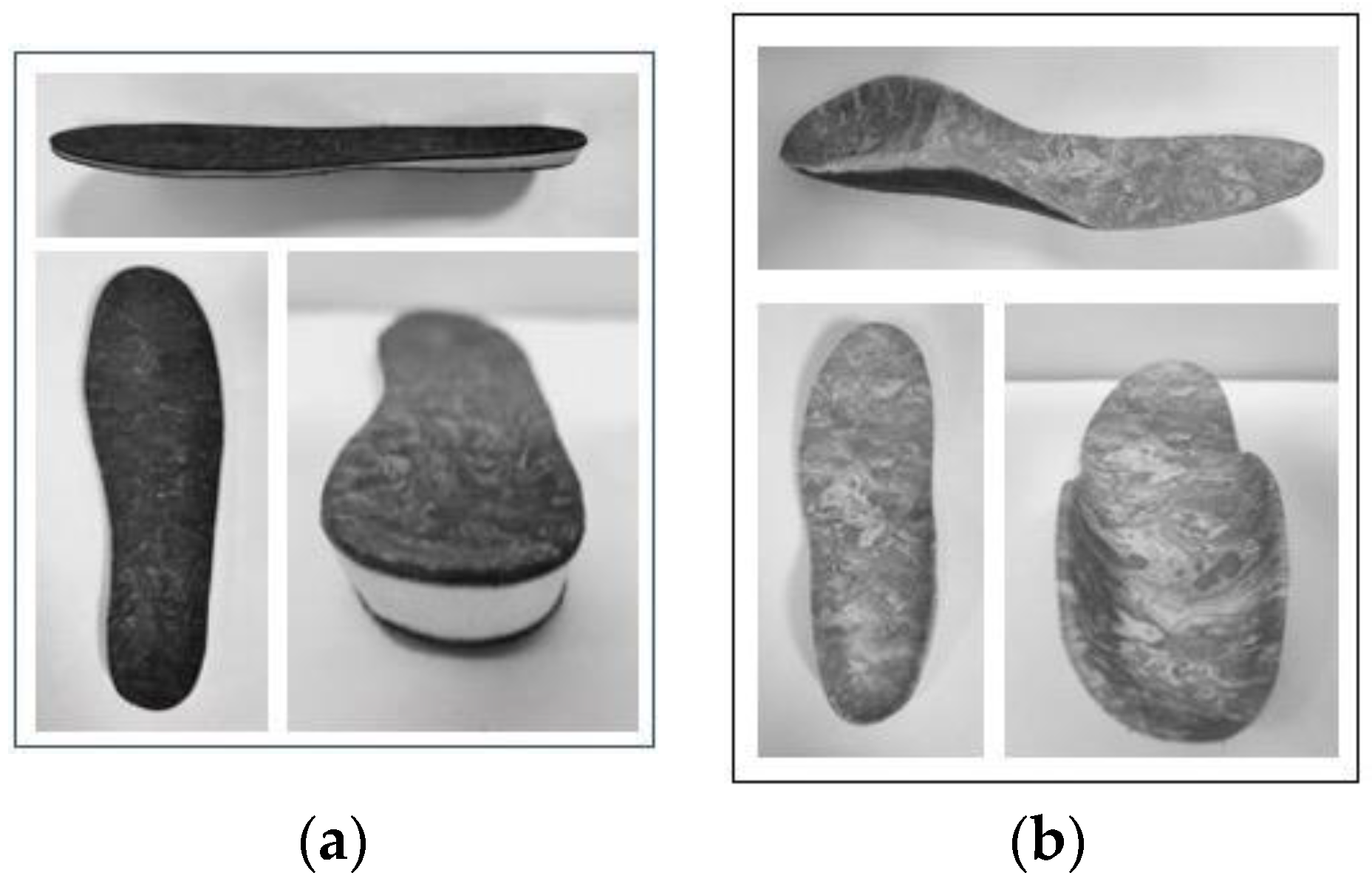
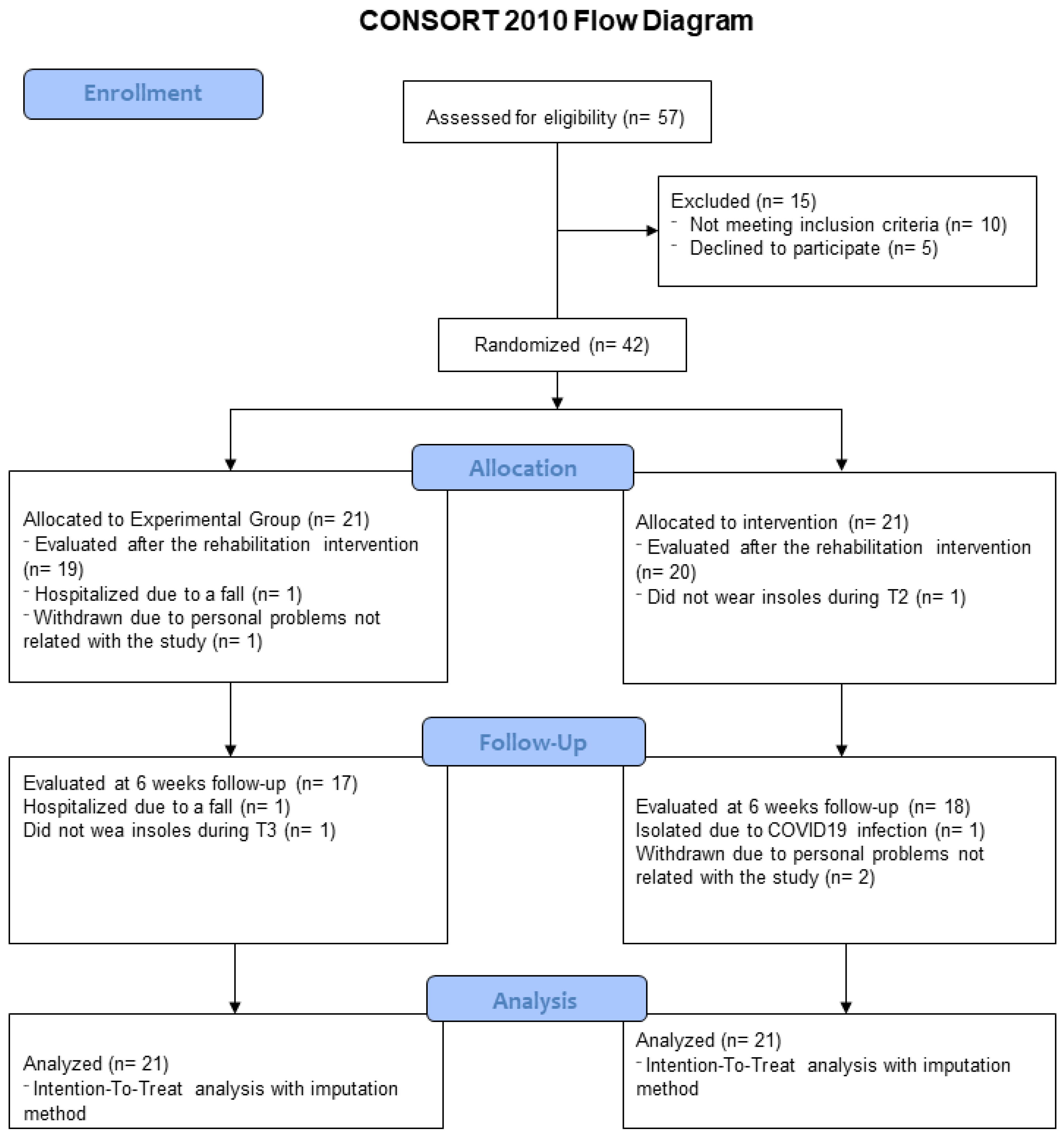
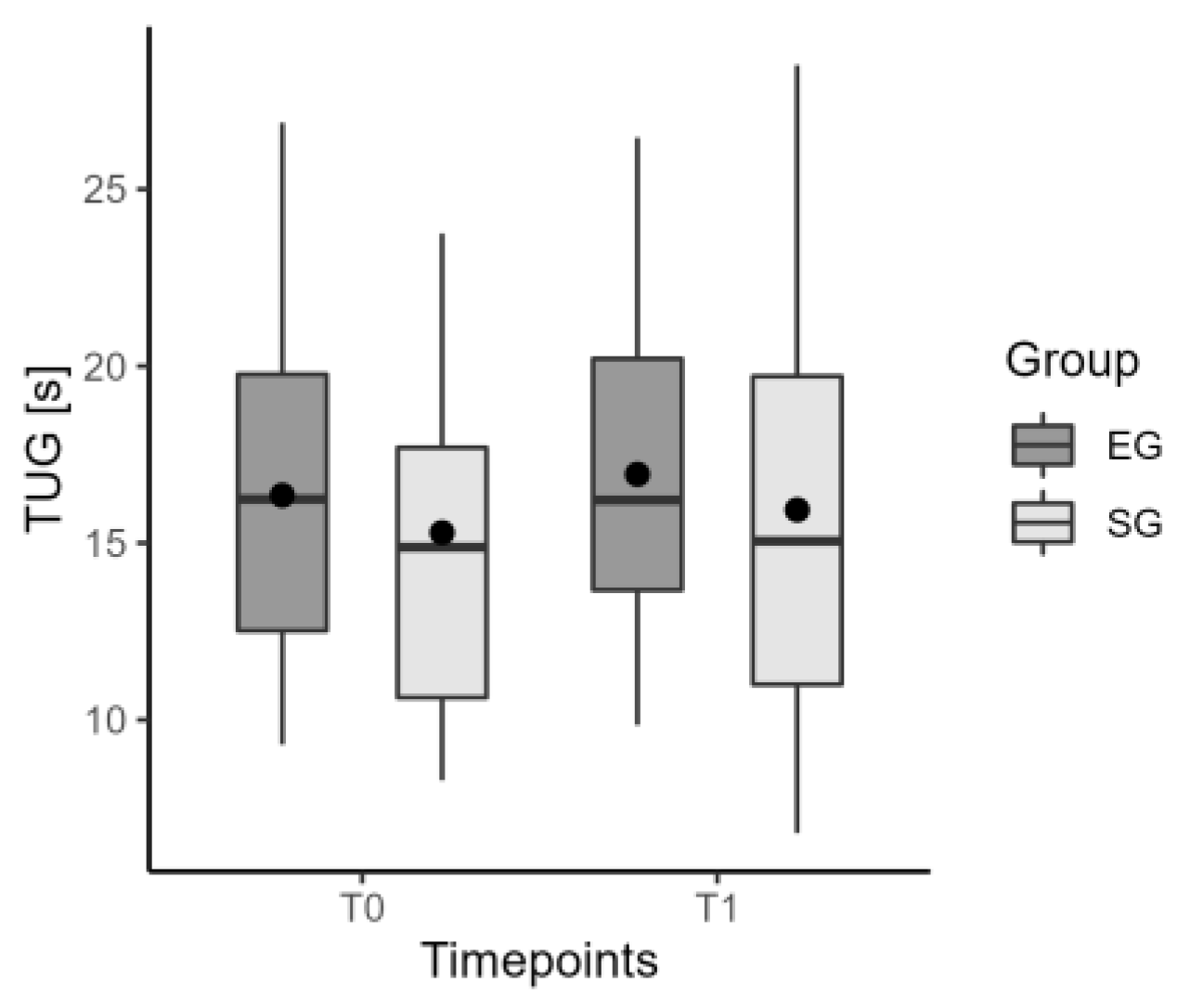
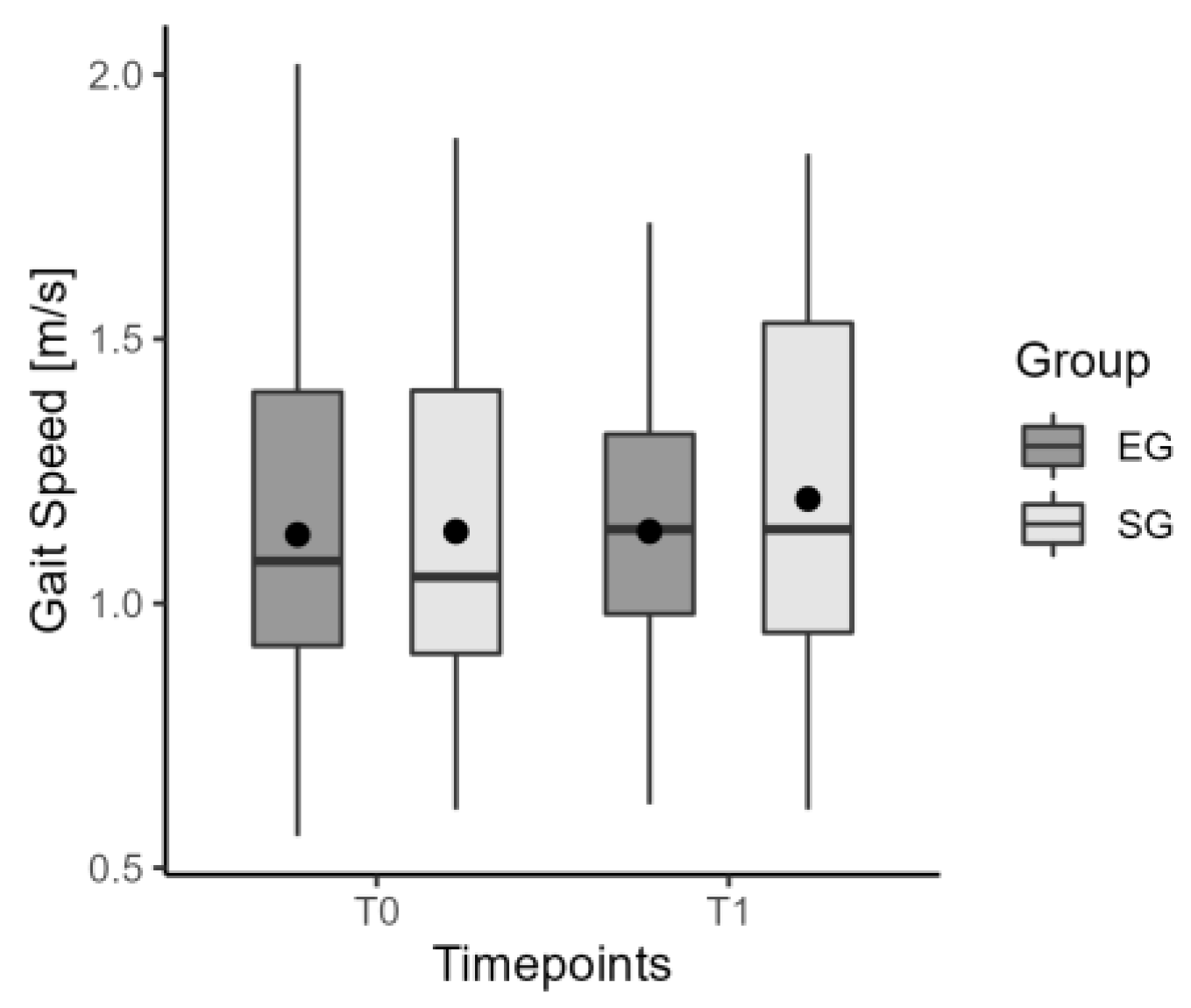
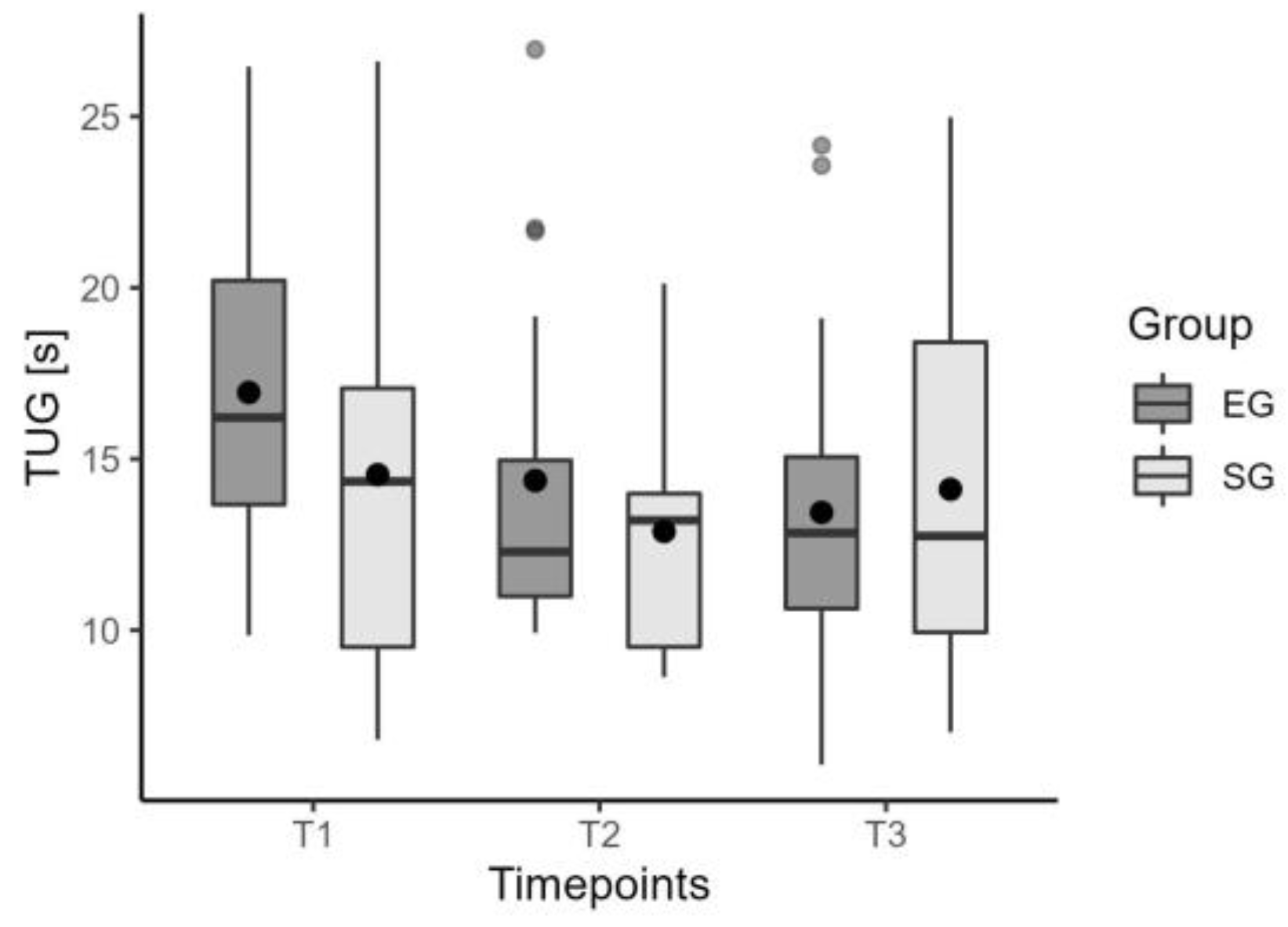
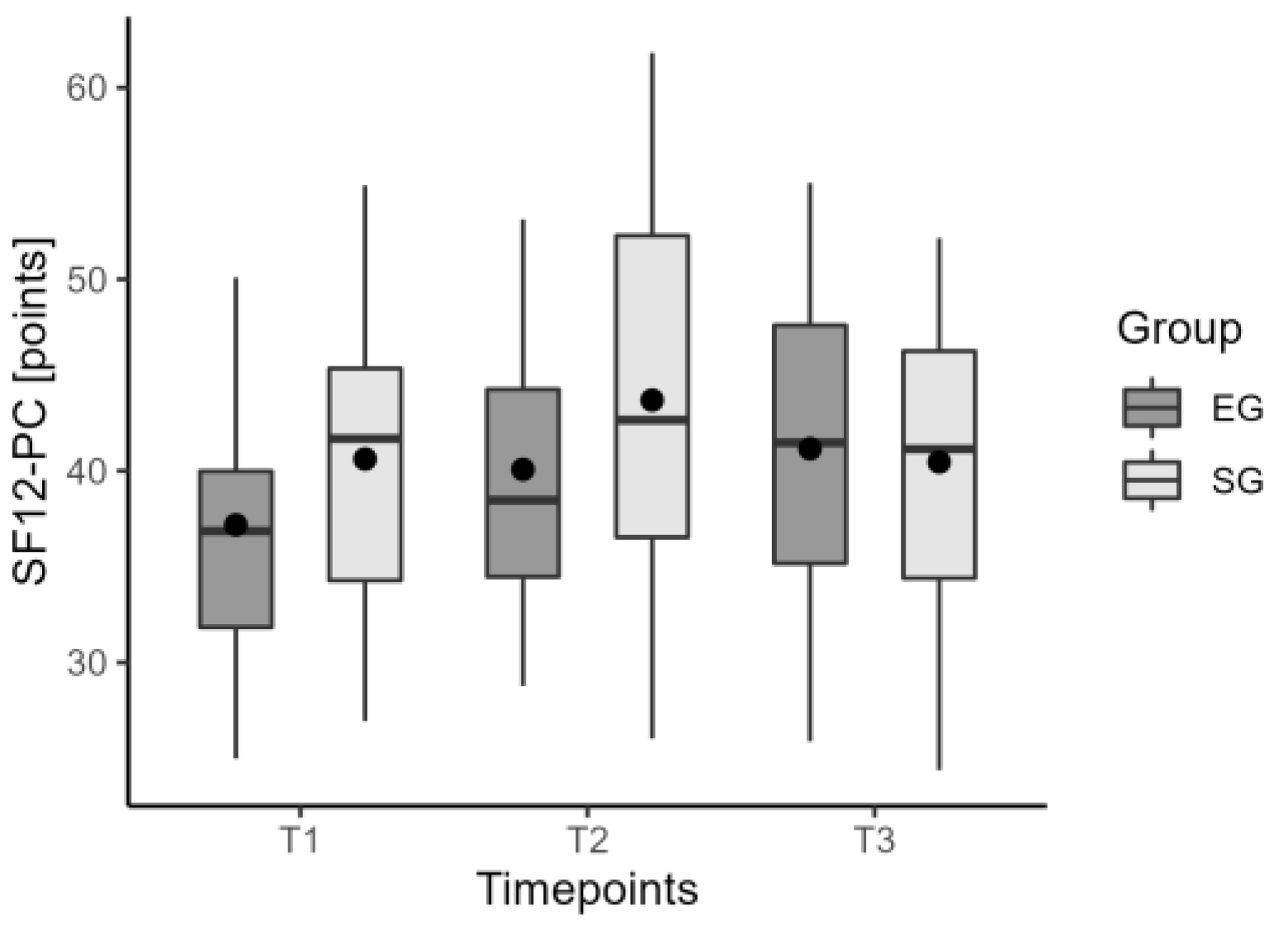

| Assessment Time-Points | ||||
|---|---|---|---|---|
| T0 | T1 | T2 | T3 | |
| Assessment time | Before the first rehabilitation session without wearing PRO-STEP (week: 0) | Before the first rehabilitation session wearing PRO-STEP (week: 0) | After the last rehabilitation session wearing PRO-STEP (week: 10) | One month after the last rehabilitation session wearing PRO-STEP (week: 14) |
| Outcome measures |
|
|
|
|
| Parameter | Experimental Group (N = 21) | Sham Group (N = 21) | p Value |
|---|---|---|---|
| Sex | F 6 (28.6%) M 15 (71.4%) | F 7 (33.3%) M 14 (66.7%) | 1 |
| Age (years) | 72.0 (7.05) | 72.0 (5.02) | 0.659 |
| Height (cm) | 169 (7.90) | 166 (9.07) | 0.181 |
| H&Y (points) | 2.05 (0.72) | 1.95 (0.97) | 0.635 |
| UPDRS III (points) | 27.1 (12.6) | 28.0 (13.6) | 0.93 |
| BBS (points) | 44.9 (9.05) | 47.00 (7.32) | 0.659 |
| Speed (m/s) | 1.13 (0.35) | 1.14 (0.37) | 0.801 |
| TUG (s) | 16.35 (5.19) | 15.29 (5.35) | 0.654 |
| T0 | T1 | T0 vs. T1 | T2 | T3 | T1 vs. T2 vs. T3 | |||||||
|---|---|---|---|---|---|---|---|---|---|---|---|---|
| F (Group × Time) | p Value (Group × Time) | F (Group × Time) | p Value (Group × Time) | |||||||||
| EG | SG | EG | SG | EG | SG | EG | SG | |||||
| TUG | 16.35 (5.19) | 15.29 (5.35) | 16.94 (4.61) | 15.94 (6.80) | 0.047 | 0.829 | 14.37 (4.71) | 12.88 (3.23) | 13.44 (4.91) | 14.11 (5.40) | 1.162 | 0.317 |
| BBS | 44.90 (9.05) | 47.00 (7.32) | - | - | - | - | 47.18 (9.07) | 51.12 (6.25) | 48.93 (9.72) | 48.76 (7.12) | 0.043 | 0.958 |
| SF12-PC | 37.18 (6.72) | 40.62 (8.32) | - | - | - | - | 39.99 (7.48) | 46.51 (9.11) | 42.35 (8.50) | 40.46 (8.28) | 0.756 | 0.472 |
| SF12-MC | 43.09 (11.81) | 43.09 (11.07) | - | - | - | - | 47.35 (9.93) | 45.57 (12.23) | 44.93 (9.31) | 44.17 (11.69) | 0.029 | 0.971 |
| Instrumented indexes | ||||||||||||
| Speed (m/s) | 1.13 (0.35) | 1.14 (0.37) | 1.14 (0.30) | 1.25 (0.36) | 0.127 | 0.722 | 1.23 (0.26) | 1.30 (0.29) | 1.21 (0.28) | 1.18 (0.31) | 0.056 | 0.946 |
| Cadence (step/min) | 109.08 (15.89) | 105.73 (15.06) | 110.59 (14.36) | 110.86 (13.91) | 0.313 | 0.755 | 110.12 (13.03) | 107.99 (10.56) | 111.94 (13.83) | 109.37 (11.13) | 0.030 | 0.970 |
| Stride Length (m) | 1.26 (0.31) | 1.29 (0.30) | 1.25 (0.27) | 1.36 (0.30) | 0.067 | 0.797 | 1.35 (0.22) | 1.45 (0.26) | 1.32 (0.22) | 1.31 (0.31) | 0.030 | 0.970 |
| Left Swing Phase (% cycle) | 39.34 (4.22) | 37.95 (3.24) | 38.99 (4.05) | 37.77 (3.39) | 0.017 | 0.898 | 38.50 (3.44) | 36.66 (2.70) | 38.36 (4.24) | 39.04 (2.53) | 1.106 | 0.335 |
| Right Swing Phase (% cycle) | 39.37 (3.32) | 38.84 (2.47) | 40.05 (4.30) | 39.01 (3.32) | 0.219 | 0.641 | 40.29 (3.12) | 38.40 (3.28) | 40.18 (3.89) | 38.38 (2.79) | 0.060 | 0.9421 |
| Symmetry Index | 88.53 (7.42) | 89.88 (9.87) | 89.14 (8.32) | 87.83 (7.71) | 0.477 | 0.492 | 91.64 (5.78) | 90.87 (7.01) | 86.15 (10.08) | 89.78 (9.58) | 0.9158 | 0.4036 |
Disclaimer/Publisher’s Note: The statements, opinions and data contained in all publications are solely those of the individual author(s) and contributor(s) and not of MDPI and/or the editor(s). MDPI and/or the editor(s) disclaim responsibility for any injury to people or property resulting from any ideas, methods, instructions or products referred to in the content. |
© 2023 by the authors. Licensee MDPI, Basel, Switzerland. This article is an open access article distributed under the terms and conditions of the Creative Commons Attribution (CC BY) license (https://creativecommons.org/licenses/by/4.0/).
Share and Cite
Pollet, J.; Buraschi, R.; Ranica, G.; Pancera, S.; Anastasi, D.; Fazio, R.; Monteleone, S.; Lena, E.; Floridi, V.; Zucchini, F.; et al. The Effect of Personalized Shoe Insoles on Parkinson’s Disease Subjects: A Triple-Blind Randomized Controlled Trial. J. Clin. Med. 2023, 12, 7204. https://doi.org/10.3390/jcm12237204
Pollet J, Buraschi R, Ranica G, Pancera S, Anastasi D, Fazio R, Monteleone S, Lena E, Floridi V, Zucchini F, et al. The Effect of Personalized Shoe Insoles on Parkinson’s Disease Subjects: A Triple-Blind Randomized Controlled Trial. Journal of Clinical Medicine. 2023; 12(23):7204. https://doi.org/10.3390/jcm12237204
Chicago/Turabian StylePollet, Joel, Riccardo Buraschi, Giorgia Ranica, Simone Pancera, Denise Anastasi, Rossella Fazio, Serena Monteleone, Eleonora Lena, Valeria Floridi, Franco Zucchini, and et al. 2023. "The Effect of Personalized Shoe Insoles on Parkinson’s Disease Subjects: A Triple-Blind Randomized Controlled Trial" Journal of Clinical Medicine 12, no. 23: 7204. https://doi.org/10.3390/jcm12237204
APA StylePollet, J., Buraschi, R., Ranica, G., Pancera, S., Anastasi, D., Fazio, R., Monteleone, S., Lena, E., Floridi, V., Zucchini, F., & Falso, M. V. (2023). The Effect of Personalized Shoe Insoles on Parkinson’s Disease Subjects: A Triple-Blind Randomized Controlled Trial. Journal of Clinical Medicine, 12(23), 7204. https://doi.org/10.3390/jcm12237204







